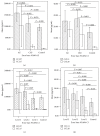The Correlation of Serums CCL11, CCL17, CCL26, and CCL27 and Disease Severity in Patients with Urticaria
- PMID: 27057079
- PMCID: PMC4737450
- DOI: 10.1155/2016/1381760
The Correlation of Serums CCL11, CCL17, CCL26, and CCL27 and Disease Severity in Patients with Urticaria
Abstract
Background: Chemokines may be involved in the pathogenesis of urticaria, but their correlation with disease severity as well as eruption type is unclear.
Objectives: The aim of this study was to explore the expression of chemokines in patients with urticaria. The association between disease severity and levels of chemokines was analysed.
Materials and methods: Serums CCL11, CCL17, CCL26, and CCL27, D-dimer, C-reactive protein, and total IgE were measured in 51 patients with urticaria and in 25 healthy control subjects.
Results: Serums CCL11, CCL17, CCL26, and CCL27 were significantly higher in patients with urticaria than in the healthy controls (P < 0.05). Serum CCL27 strongly correlated with urticarial disease severity. Serums CCL17, CCL26, and CCL27 significantly correlated with D-dimer, while innercorrelations were noted among the chemokines.
Conclusion: Our findings reveal that chemokines participate in the pathogenesis of urticaria. Further study in larger cohort is needed to testify whether they could be the biomarkers for predicting the severity of urticaria.
Figures


Similar articles
-
Serum levels of Th2 chemokines, CCL17, CCL22, and CCL27, were the important markers of severity in infantile atopic dermatitis.Pediatr Allergy Immunol. 2008 Nov;19(7):605-13. doi: 10.1111/j.1399-3038.2007.00692.x. Epub 2008 Feb 6. Pediatr Allergy Immunol. 2008. PMID: 18266834
-
Serum TARC and CTACK concentrations in children with atopic dermatitis, allergic asthma, and urticaria.Pediatr Allergy Immunol. 2012 May;23(3):278-84. doi: 10.1111/j.1399-3038.2011.01225.x. Epub 2011 Oct 21. Pediatr Allergy Immunol. 2012. PMID: 22017510
-
Serum cytokine and chemokine profiles in patients with alopecia areata.J Dermatolog Treat. 2016;27(3):260-3. doi: 10.3109/09546634.2015.1093591. Epub 2015 Oct 7. J Dermatolog Treat. 2016. PMID: 26367497
-
CCL27 Signaling in the Tumor Microenvironment.Adv Exp Med Biol. 2021;1302:113-132. doi: 10.1007/978-3-030-62658-7_9. Adv Exp Med Biol. 2021. PMID: 34286445 Review.
-
CCL27/PESKY: a novel paradigm for chemokine function.Expert Opin Biol Ther. 2003 Feb;3(1):15-22. doi: 10.1517/14712598.3.1.15. Expert Opin Biol Ther. 2003. PMID: 12718728 Review.
Cited by
-
Eotaxin-3 as a Plasma Biomarker for Mucosal Eosinophil Infiltration in Chronic Rhinosinusitis.Front Immunol. 2019 Feb 4;10:74. doi: 10.3389/fimmu.2019.00074. eCollection 2019. Front Immunol. 2019. PMID: 30778348 Free PMC article.
-
Immune response proteins as predictive biomarkers of doxorubicin-induced cardiotoxicity in breast cancer patients.Exp Biol Med (Maywood). 2018 Feb;243(3):248-255. doi: 10.1177/1535370217746383. Epub 2017 Dec 9. Exp Biol Med (Maywood). 2018. PMID: 29224368 Free PMC article.
-
Serological profiling reveals hsa-miR-451a as a possible biomarker of anaphylaxis.JCI Insight. 2022 Apr 8;7(7):e156669. doi: 10.1172/jci.insight.156669. JCI Insight. 2022. PMID: 35202004 Free PMC article.
-
Urticaria and Angioedema: an Update on Classification and Pathogenesis.Clin Rev Allergy Immunol. 2018 Feb;54(1):88-101. doi: 10.1007/s12016-017-8628-1. Clin Rev Allergy Immunol. 2018. PMID: 28748365 Review.
-
Adjunct therapy with probiotics for chronic urticaria in children: randomised placebo-controlled trial.Allergy Asthma Clin Immunol. 2021 Apr 17;17(1):39. doi: 10.1186/s13223-021-00544-3. Allergy Asthma Clin Immunol. 2021. PMID: 33865434 Free PMC article.
References
Publication types
MeSH terms
Substances
LinkOut - more resources
Full Text Sources
Other Literature Sources
Medical
Research Materials

